Vattayappam/steamed rice cake is a typical Kerala sweet dish. This is made from raw rice and coconut. We can have it as a tea-time snack or even for breakfast. It is difficult to make vattayappam without steamer. Here I am sharing an idea to make the vattayappam without a steamer.
Ingredients
1. Raw Rice – 3 1/2 cup (you can use idli rice/sona masoori )
2. Parboiled rice/Kerala rosematta rice / kuthari – 1/2 cup
3. Cooked rice preferably Kerala rosematta rice – 1 cup
4. Coconut milk – 1cup or Grated coconut and coconut water or plain water
5. Sugar – 1/2 cup
6. Yeast – 1/2 tsp
7. Raisins/Cashews – to garnish
8. Salt
Method
1. Wash the rice( idli rice and parboiled rice) and soak it at least for 5-6 hrs.
2. Drain it. Grind the rice with cooked rice by adding coconut milk and little water if needed to a fine paste (If you are using grated coconut – grind the raw rice, cooked rice, grated coconut by adding coconut water or plain water).
3. Add the yeast, sugar, mix well,close with a lid and keep it in a warm place to ferment ( at least 8 – 9 hrs).
4. Add salt before preparing and check for sugar. If your batter is too thick, dilute it with whole milk/coconut milk. The consistency should be that of an idli batter. Keep aside for 20 minutes.
5. Grease a flat round pan (or idli moulds) and pour the batter to it (fill up to half the pan), and double boil in a larger pan or steam in an idli steamer.
6. When the appam is half done, garnish it with raisins and cashews. Steam again. The whole process would not take more than 20 – 25 mts.
7. When it is cooked, remove from the heat and cool in the same pan. If it is cooked properly, it won’t stick to the knife or spoon.
8. When it cools down, gently take out and cut into any desired shapes.
Vattayappam with Rice Flour
Ingredients
- Raw rice flour – 3 cups
- Rice flour – 2 tsp + Rava / semolina – 2 tsp (kappi kachan)
- Cooked rice – 1/2 cup
Grated coconut – 1 cup or coconut milk – 1 cup
Sugar – 1/2 cup
Yeast – 1/2 tsp
Raisins/Cashews – to garnish
Salt
-
1. Mix 2 tsp rice flour and 2 tsp rava/ semolina with 1 cup of water.Transfer it to a pan and stir continuously in low flame until it turns to a thick paste. Remove from the fire and cool it.
2. Grind the grated coconut and cooked rice with enough coconut water / plain water to a very fine paste.
3. Place 3 cups of rice flour in a large vessel. Add the rice flour/rava paste (step 1) and the coconut-cooked rice paste (step 2). Mix well. Add the yeast, sugar and mix well to make a smooth batter. You can add little water if required. The consistency should be that of an idli batter so do not add too much water. Mix well, close with a lid and keep it in a warm place to ferment ( for at least 8 – 9 hrs). During winter you can keep this mixture in a warm oven with lights on.
4. Add salt just before preparing and check for sugar. If your batter is too thick, dilute it with whole milk/coconut milk. The consistency should be that of an idli batter. Keep it aside for 20 mts.
5. Grease a shallow round pan and pour the batter to it, and double boil in a larger pan.
6. When the appam is half done, garnish it with raisins and cashews. Steam again until done. The whole steaming process would not take more than 20 – 25 mts.
7. When it is cooked, remove from the heat and cool in the same pan. If it is cooked properly, it won’t stick to the knife or spoon.
8. When it cools down, gently take out and cut into any desired shapes. Enjoy!!

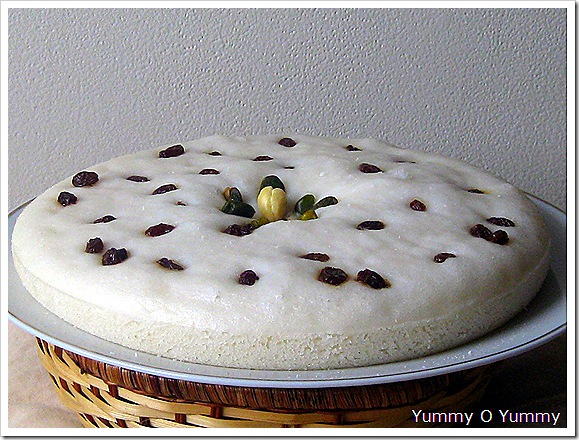
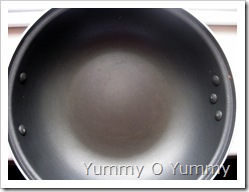
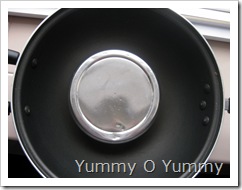
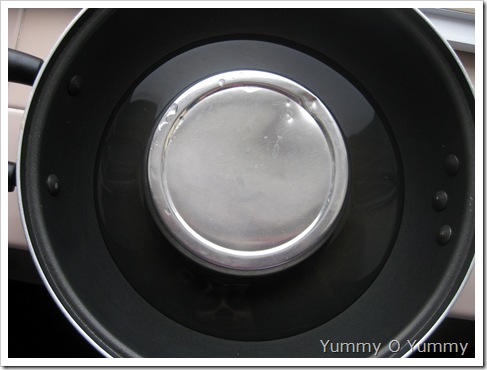
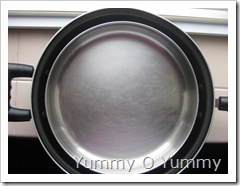
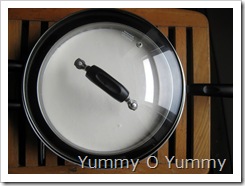
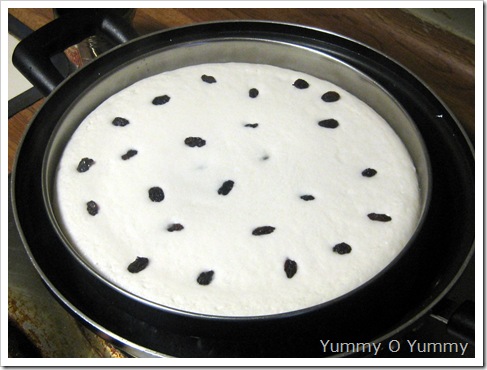
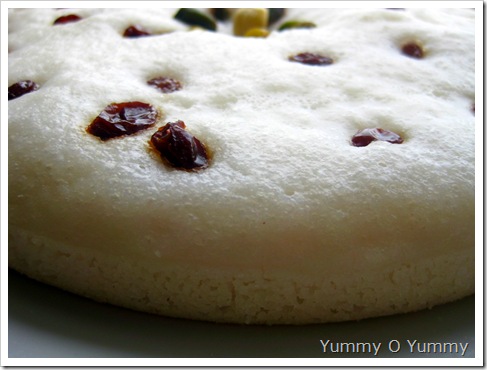
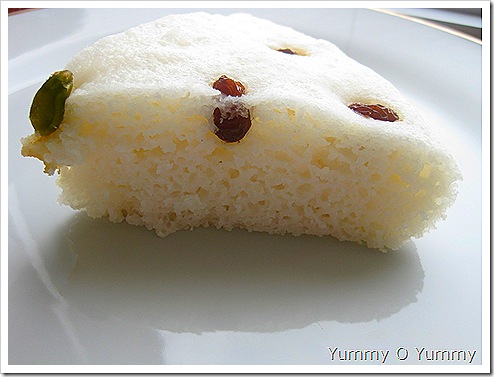




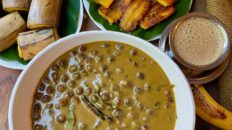


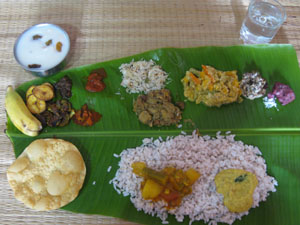
Beautiful Pictures..
Thanks
Fabulous pics..It looks super-delicious!
Oh my, my… :)) Didn’t know what to say after that last pic. Beautifully captured.
We can pour the batter in a flat container and steam in a pressure cooker (like dhokla) with out the weight ofcourse, right?
And what is Kerala rice?
Thanks for a traditional feast.
Suma,
Thanks a lot for your lovely comment:) You can do it the same way as you mentioned with a pressure cooker. By Kerala rice we were referring to the rosematta rice/kerala red rice/red parboiled rice.
looks so delicious..
today i prepared the vattayappam..i used the store bought rice flour it came out really good
PranisKitchen,
Thanks a lot for your feedback on our dish. Hope you try more of them.
Perfect………really hat’s of to you.
Vattayappam kollam, nanayitu undu.
This comment has been removed by a blog administrator.
Hey maya.. the pics looks fantabulous. I really feel like havin a bite of it. Looks sooo delicious… Nice job
-Neeraj
Maya the texture looks perfect.. Will try this for sure!!!!!!!
Can you send me the quantity of ingredients if I want to use rice flour (instead of raw rice and kerala rice) for this recipe…
Rusheeda,
We haven’t tried this recipe with rice flour. But we will surely post its recipe here sometime. Sorry about that..
Hi Yummy Team,
I tried the vattayappam using exactly half the quantity of ingredients (rice flour method). It was steamed in a pressure cooker (like how Suma mentioned) for about 15 mins.
But the appam turned out a little harder (rather than spongy) and powdery (like puttu).
Also found difficulty in upturning it though I greased the plate with ghee).
May be the mistake I made was that I didn’t use a shallow plate. I used a cake tin instead.
Rusheeda,
I am really sorry that your vattayappam didn’t come out well. I guess it’s okay to use a cake pan (a small one since you halved the recipe) instead of a steel plate.
The consistency of the batter and fermentation might affect the texture of the vattayappam. The batter should not be very loose in consistency and should rise to almost double its size. And since you have halved the recipe, you might want to reduce the steaming time accordingly especially if you have used a large shallow cake pan. Vattayappams tend to harden if cooked for a long time. Cooking time depends on consistency of the batter and the dimensions of the plate that you use. You can insert a knife to check whether it is done.
Also, to turn it out, run a knife through the sides of the pan and gently upturn it on to a plate or try lifting it with a metal spatula. I will get back to you with more tips from experts Hope it will come out well next time.
Hope it will come out well next time.
No issues..I shall try out again next time. Thanks for the advice.
You’re welcome Good luck on your second attempt! I am waiting for your feedback..
Good luck on your second attempt! I am waiting for your feedback..
Hi! Yummy:
May I know if it is possible that a raw powdery-white rice flour bought from local groceries could be directly put or cook in the steamer using 3-inches diameter tart mould? I mean, is the rice flour can be cooked directly to the steamer without the need of being it mixed with water?
If so, what ingredients or powder safe chemicals do I need to put or mix in the rice flour so that it can be easily cooked/done when directly place in my conventional steamer in less than a minute without the need of any liquid, like: water, milk, or coconut water to soak it?
Thank you very much.
dodz
it was god dear .. god bless